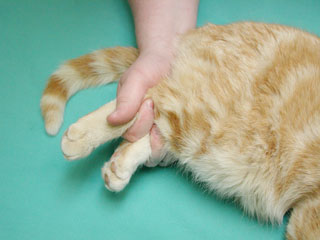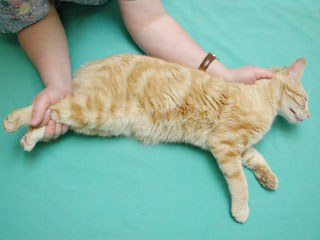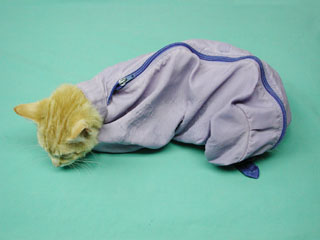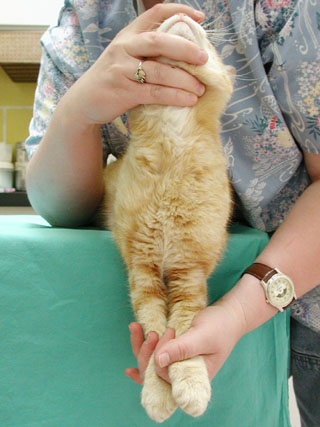
| Figure #1: The scruff of the neck is a common location to use to restrain a cat. A firm grip in this area allows the handler to control the catís head but does not cause significant discomfort for the cat. |
Introduction:
Handling a cat in a way that is safe for both the pet and person should be the common goal. Always approach the cat with confidence and handle it gently. Most cats can be coaxed into accepting a procedure and do not need to be restrained. If restraint is needed, however, there are several methods of properly handling a cat. The technique used will depend on if the cat is aggressive or cooperative. In general, most procedures are best carried out with a minimum of physical restraint.Picking Up a Cooperative Cat:
Generally, it is recommended that the cat be picked up from above. Place one hand around the catís abdomen and chest and gently take hold of the catís front legs, keeping an index finger between them for a secure grip. Hold the cat close to the body and under one arm, while cradling the catís chin with the other hand.Picking up an Aggressive Cat:
Reach down and lift the cat up by the scruff of the neck (see figure #1), and control the catís hind limbs with the other hand (see figure #2). Keep the cat in an upright position, with one hand on the scruff and one on the hind feet. If the cat is frightened, first cover the cat with a towel. After a few minutes, the cat will often calm down enough to where the scruff can be held or the rest of the towel can be slid completely around the cat to form a cradle. Wrapping a towel or blanket around the cat has a calming effect.Picking up and Transporting an Injured Cat:
When handling an injured cat, be aware that even the most friendly cat may scratch or bite because of pain. Take every precaution necessary to prevent additional injury to the pet or subsequent injury to the person doing the handling. Approach the injured cat calmly and quietly. If the cat is severely injured, evaluate the pet for consciousness, breathing, and heart beat. Utilize the suggestions found on page E200 for emergency treatments. Once the cat is stabilized, evaluate the extent of the injuries. If the cat is conscious and alert, but has no external signs of severe injury, carefully pick up the cat using the suggestions found previously in "Picking up the Cooperative Cat." Avoid handing any regions of the body that appear to be injured. Once the cat is contained, place it in a carrier or box that is covered so the cat cannot look out. If the cat has injuries to the back or neck, slide a thin board or firm, flat piece of cardboard under the cat. The board will help prevent additional injury and can be used to help transport the cat to the veterinary hospital. In all situations, cover the catís body and head with a towel to help keep it calm and warm, and transport the pet immediately to a veterinarian. A towel can be placed over a cat that is too aggressive or in too much pain to handle. After the towel is over the cat, place a box or large container over the animal. Raise the edge of the box and slide the lid or top to the box underneath the cat. The box does not need to be turned over to safely transport the cat.Restraining for Treatment or Diagnostics:
The following pictures and captions demonstrate some common ways of restraining a cat.

|
|

|
|

|
|

|
|
No matter what technique is used to restrain a cat, safety for both the cat and the people doing the handling is of utmost importance.